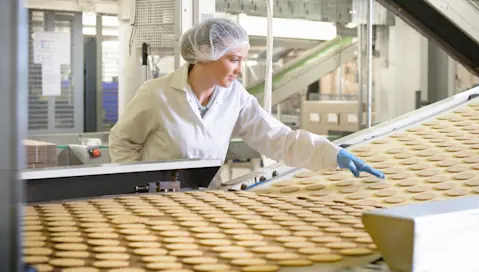Uitgelicht in deze blog
7 Steps for Mastering Food Quality Control and How ERP Facilitates Excellent Results
7 Steps for Mastering Food Quality Control and How ERP Facilitates Excellent Results
15 Nov 2021
Jack Payne
For a food and beverage business like yours, it all comes back to quality. At the end of the day, consumers want to know that they’re getting their money’s worth from the products they buy. And there’s no better way to guarantee their satisfaction than to ensure that every item leaving your facilities and moving downstream is up to the same high standards you’ve set.
The advantages of maintaining consistent excellence in quality are better brand reputation and greater profitability—after all, it stands to reason that if you can put a better product on the shelf, your company will be held in higher regard and customers will choose your offering over competitors. Meanwhile, the risks of not implementing adequate quality measures are significant, with a loss of market share or food safety emergency potentially on the line.
Of course, there are a number of key quality procedures in the food and beverage industry, and you’ll need purpose-built technology like an enterprise resource planning (ERP) solution to really ace them all. Let’s take a look at seven ways to cover your food quality control concerns and how ERP systems can facilitate your efforts.
1. Establish Your Approved Supplier List
Your organization likely works with a few trusted, regular material providers, but it’s worth codifying your list of approved suppliers by ingredient to be assured that you’re starting with the best components before the manufacturing process begins. You should include in this list the specific name of the ingredient and your internal code or identifier for it, as well as the full contact details of the supplier(s) associated with it.
ERP platforms can help you capture all of this information—as well as the contracts that you sign with suppliers—and maintain it all digitally in an easy-to-access, company-wide database. That way, everyone is informed of exactly where your ingredients are coming from, and you can ensure that you are always purchasing from the providers that you’ve approved beforehand.
2. Set Ingredient Specification Requirements
It’s becoming something of a cliché to say that your products are only as good as what you put in them, but the sentiment rings with truth. You need to clearly define what’s acceptable in terms of sourcing, shelf life, composition, packaging, country of origin and purity—among other characteristics depending on the type of ingredient—and communicate them clearly to your providers.
Food ERP solutions aid on this front by storing this information digitally and making it highly visible to all parties involved. Then, when materials are received and they are assessed, there’s a clear list of requirements to compare against your employees’ findings, and they can determine whether everything is up to snuff or needs to be returned to the supplier for replacement.
3. Manage Recipes and Formulas Precisely
Your product development teams took great time and care to optimize the recipes for your food and beverage offerings, and your customers expect consistency when they choose to purchase their favorite items over and over again. That makes creating very detailed and specific formulas and strictly adhering to them crucial for you as a business.
While almost all industry-specific food ERP platforms will have some form of recipe management functionality, advanced systems like Aptean Food & Beverage ERP take it a step further by integrating with smart manufacturing equipment and importing data from them in real time. This lets you know immediately if an individual item or production run is deviating from the norm, allowing your staff to intervene and correct the issue.
4. Follow Good Manufacturing Practices and Compliance Regulations
Current Good Manufacturing Practices (cGMP) for food and beverage companies were established by the U.S. Food and Drug Administration to help optimize results and minimize risks in the production, processing and packaging of food and beverage products. The guidelines were included in the Federal Food, Drug and Cosmetic Act and continue to provide a solid basis for safe and effective operations.
Other highly recognized certifications, like the British Retail Consortium Global Standards (BRCGS), Safe Quality Food Institute (SQFI) provisions, Hazard Analysis and Critical Control Points (HACCP) methodology, Foundation Food Safety System Certification 22000 (FSSC 22000) and International Organization of Standardization provisions (ISO 22000), can be worthwhile to obtain as an additional measure. Also, depending on where your facilities are located and which countries your products are sold in, you have the legal responsibility as an organization to adhere to all necessary food safety and compliance regulations, such as those set forth by the Food Safety Modernization Act (FSMA) in the U.S.
On this front, food ERP solutions help enforce applicable standards by automatically scheduling checks of your processes and compliance measures. By routinely scrutinizing your operations, equipment and personnel behaviors, you can create a culture of food safety and good practices that will go a long way in maintaining the quality of your products.
5. Collect and Monitor Food Quality Data in Real Time
Carefully monitoring the production process while your lines are running is critical for making sure your results meet your expectations. Unless you’ve got an eye on exactly what’s going on and how your equipment is operating, you run the risk of wasting materials through use in products of unacceptable quality that must be scrapped, costing you money and detracting from the sustainability of your business.
ERP systems built for the food and beverage industry tend to have built-in quality management features that facilitate the gathering and analysis of in-process quality data, but not all are created equal in this regard. Aptean Food & Beverage ERP’s ability to integrate with smart sensors, scales and thermometers helps collect vital information—from cooking temperature and consistency to color, shape and any other key aspects—and updates your interface immediately so that problems can be identified and rectified proactively.
6. Ensure Proper Packaging and Labeling
While not directly associated with the quality of your products, the packaging and labeling of finished goods can have a big impact on consumers’ experiences. You need to ensure that the primary packaging (i.e., that which comes in direct contact with the product) is appropriate to the type of food or beverage it contains; the secondary packaging (any material that bundles multiple products together) suits the shape and durability of the items inside; and all necessary labels are applied properly.
For these reasons, robust packaging and labeling management features are an important component of food and beverage ERP platforms. With these tools, you’ll be able to set the specifications by product type and quickly print the required labels that contain all relevant information tied to the product, including nutritional info, ingredient lists and allergen declarations.
7. Create a Detailed Recall Plan
As critical as taking these proactive steps toward meeting quality standards are, it’s also vital to have a plan in place should something go awry and a product withdrawal or recall is necessary. There is nothing worse than having to scramble in a situation where time is of the essence, and that is certainly true in food safety emergencies, especially with additional scrutiny being put on the industry by both regulatory bodies and customers.
Industry-built ERP systems can not only help you identify errors and track the source of contamination back in the supply chain with complete traceability features—they can also automate certain parts of the recall process, such as issuing notifications to affected parties. With the visibility these systems afford businesses like yours, you won’t have any questions as to where the problematic material originated, nor what products in which it was incorporated.
Uncompromising Quality: It Takes the Right Technology
It’s clear from this list that food quality control can’t be accomplished with a single pass or superficial check of various attributes as items come off the production line. It’s an involved process that necessitates action from the time ingredients enter your facilities to the moment finished goods leave for their eventual destinations.
It should also be apparent just how far the right technological solution can go in enabling your organization to accomplish all that’s called for on this front. When food ERP systems can automate quality checks and guarantee they’re done right every time, you relieve your staff of the burden of manual recording processes and eliminate the margin for human error.
We’ve noted a few of the ways in which our industry-specific food and beverage solution, Aptean Food & Beverage ERP, excels on the quality assurance front, but there are other great reasons to trust us for your enterprise software needs. Our teams have decades of food and beverage industry knowledge, and our solutions are all built on the foundation of Microsoft Dynamics 365, which lends them both familiarity as well as the advantages of all the latest developments and updates.
We’re ready to talk about how one of our flexible cloud deployments or on-premise installations will help your business reach its goals and look forward to guiding you through a successful implementation.
Reach out to us today to learn more about Aptean and our best-in-class offerings, or request a personalized demo to get your digital transformation started.
Wilt u weten wat we voor uw voedingsbedrijf kunnen betekenen?
Wij helpen u graag. Neem contact met ons op en ontdek welke smaken we te bieden hebben.



